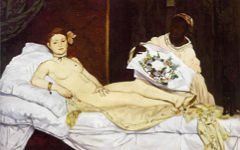Manet (Brief Introduction)
Edouard Manet, a key figure on EPPH, was both the last Old Master and the first Modern artist. Understand his art and you are on your way to understanding the work of Raphael, Rembrandt, Picasso, Freud or any other great artist. The irony is, though, that while Manet’s paintings are easy on the eye and seemingly accessible, art historians remain baffled. The curator of his paintings in the Louvre called him “one of the most enigmatic, least classifiable artists in the history of painting.”1 Translated, that means: we understand little.
Many scholars note that Manet’s paintings are full of “visual inconsistencies”, even “mistakes”. Widely discussed, these "errors" have never been recognized before as keys to making sense of his art.2 Yet once the true scene is recognized, all these problems disappear. As for the “mistakes”, they were not errors in the first place but “misperceptions” on the viewer’s part, not the artist’s. Take, for example, the right-handed musician in The Spanish Singer whose guitar is strung for a left-handed player. All critics note that. Once you understand, as we show here for the first time, that the whole scene takes place in a mirror, the problem corrects itself. The mistake was ours’, not Manet’s.
Study the explanations of his art on EPPH and you will begin to learn the methods of the masters, most still unknown to art historians as well. Many of his canvasses, for instance, are not even set in modern Paris as long believed but are scenes of their own creation in a studio and in his mind. Enjoy them because, even though they are full of profound wisdom, they also make looking at art fun.
More Works by Manet
Notes:
1. Françoise Cachin, "Introduction", Manet, 1832-1883 (Metropolitan Museum) 1983, p.13
2. Nan Stalnaker, “Intention and Interpretation: Manet’s Luncheon in the Studio”, The Journal of Aesthetics and Art Criticism 54, Spring 1996, p. 129
Original Publication Date on EPPH: 30 Dec 2010. | Updated: 0. © Simon Abrahams. Articles on this site are the copyright of Simon Abrahams. To use copyrighted material in print or other media for purposes beyond 'fair use', you must obtain permission from the copyright owner. Websites may link to this page without permission (please do) but may not reproduce the material on their own site without crediting Simon Abrahams and EPPH.



